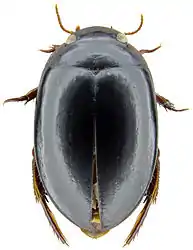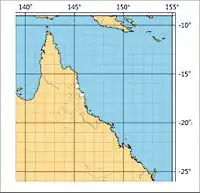Taxonavigation
| Taxonavigation: Adephaga |
|---|
|
Superregnum: Eukaryota |
Familia: Dytiscidae
Subfamilia: Agabinae
Genus: Platynectes
Species: Platynectes larsoni
Name
Platynectes larsoni Hendrich & Šťastný, 2014
Type locality
Windsor Tableland, Windsor Tableland access road, 16.232S 145.024E, 1100 m, Queensland, Australia.
Type material
Holotype: male: “AUSTRALIA QLD Windsor Tableland Feb 6–8/91 Larson & Storey”, “Platynectes compactus Larson n.sp. MS name” “Holotype Platynectes larsoni sp. n. Hendrich & Šťastný 2014 des.” [red printed label] (ANIC). Paratype, one female: “AUSTRALIA Qld. Mulgrave R. Kearney´s Falls Oct. 6, 1990”, “Platynectes compactus Larson n.sp. MS name” (ANIC). Provided with a red printed paratype label.
Diagnosis
Body small, roundish-oval, oblong, usually shiny, black with one yellow spot on each elytron (Fig. 1).
Description
Measurements: Holotype: TL = 6.3 mm, TL-H = 5.8 mm; width = 3.8 mm. Paratype: TL = 6.35 mm, TL-H = 5.85 mm; width = 3.85 mm.
Head: completely black. Microreticulation absent. Reticulation strong, consisting of small meshes and larger punctures at interspaces of meshes and of minute punctures inside meshes. Two very small and shallow clypeal grooves on disc and a shallow transverse depression formed by deep and coarse punctures beside eyes. Antennae testaceous, short; antennomeres short. Apical two antennomeres not reaching elytron.
Pronotum: completely black, shiny with margins testaceous. Posterior angles of pronotum acute. Reticulation strong, consisting of small meshes and larger punctures at interspaces of meshes and of minute punctures inside meshes. Longitudinal median suture visible but very short. Anterior and posterior rows of punctures coarse;punctures moderate to small and well separated. Lateral margin completely bordered.
Elytron: black, shiny with one subbasally small yellow spot on each elytron. Epipleura reddish. Microreticulation present but very fine, visible at higher magnification (100×). Reticulation fine and visible at usual magnification (80×), consisting of small meshes and larger punctures at interspaces of meshes and of minute punctures inside meshes. Sutural row of punctures absent. Two discal and one lateral row of small punctures present, vanishing short before elytral base.
Ventral surface: rufo-piceus. Legs rufo-testaceous. Prosternal process broad, 1.5 times as long as broad, distinctly bordered at sides, and sharply pointed out at apex. Metaventral wings very narrow. Metacoxal lines raised, well separated, a little divergent in anterior half. Metacoxal plate with few narrow scratches, microreticulation consisting of minute punctures. Abdominal ventrites 1, 2, 3 and 4 laterally with a yellow spot. Last ventrite narrowly microreticulate with minute punctures and with some strong oblique striations. Posterior margin bordered and broadly rounded.
Male: Protarsus little expanded, moderately clothed with setae ventrally. Aedeagus: Median lobe regularly curved in lateral view, apically rounded (Fig. 2 - 11). Parameres basally broad with long setae, apical third narrow and elongate (Fig. 2 - 12).
Sexual dimorphism: The female paratype differs from the male holotype in the following characters: Striation on last abdominal ventrite reduced to a series of punctures, pro- and mesotarsomeres 1–3 not dilated and without adhesive setae, and meshes of dorsal surface reticulation more deeply engraved, surface appearing less shiny.
Affinities
Among the Australian members of the decempunctatus-group P. larsoni sp. n. is characterized by its almost black color with only one yellow spot on elytra, the small size, and the roundish-oval body. It is similar to P. tasmaniae (Clark, 1863) but can be separated by the shape of the median lobe and the short antennae with short and stout antennomeres.
Habitat
Lotic. The female was collected near a waterfall and the male most probably at the type locality of Batrachomatus larsoni Hendrich & Balke, 2013, a small rain forest stream along the Windsor Tableland access road (see Hendrich & Balke 2013).
Etymology
This species is dedicated to our Canadian colleague David Larson (Maple Creek, Canada) who collected the only known specimens and recognized the species as new. The specific epithet is a substantive in the genitive case.
Distribution
(Fig. 3). Windsor Tableland and Mulgrave Range in north-eastern Queensland.
Images
 Figure 1. Platynectes larsoni. (Photo: Michael Balke)
Figure 1. Platynectes larsoni. (Photo: Michael Balke) Figure 2. Median lobe and parameres of Platynectes larsoni. (Drawing: Jaroslav Šťastný)
Figure 2. Median lobe and parameres of Platynectes larsoni. (Drawing: Jaroslav Šťastný) Figure 3. Distribution map of Platynectes larsoni, north-eastern Queensland, Australia
Figure 3. Distribution map of Platynectes larsoni, north-eastern Queensland, Australia
References
- Hendrich, L.; Šťastný, J. 2014: Taxonomic revision of Australian Platynectes Régimbart, 1879 (part I)—four new species from Queensland (Coleoptera: Dytiscidae, Agabinae). Zootaxa 3795(1): 25–37. DOI: 10.11646/zootaxa.3795.1.3 Reference page.